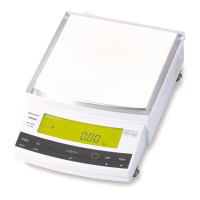Do you have a question about the Shimadzu UX620H and is the answer not in the manual?
Emphasizes critical safety instructions that must be followed.
Details components of large and small pan models, including common parts.
Explains the function of each key during weighing and menu selection.
Describes various display symbols and their meanings on the balance.
Provides criteria for selecting an optimal and safe location for the balance.
Details the standard packed items and how to check for damage.
Provides step-by-step instructions for physically installing the balance.
Explains how to connect the power and start the balance.
Details the process for adjusting the balance's accuracy.
Guides users on how to perform standard weighing procedures.
Covers the necessary settings on the balance for data transfer.
Explains how to physically connect the balance to a computer.
Guides users on configuring the computer for data transfer.
Details how to initiate and verify the WindowsDirect data transfer.
Provides solutions for common issues with data transfer.
Details the step-by-step process for selecting and setting menu items.
Explains how to input numerical data for various settings.
Defines calibration and when it should be performed.
Covers the process of performing calibrations.
Details span calibration using the internal weight for UW series.
Explains how to check calibration using the internal weight.
Details span calibration using external calibration weights.
Explains how to check calibration using external weights.
Allows configuration of calibration parameters.
Guides selection of internal or external calibration methods.
Explains the automatic calibration function based on temperature.
Details scheduled automatic span calibration.
Covers password-protected calibration of internal weights.
Explains how to optimize stability and response for different applications.
Covers settings related to stability detection for data output.
Lists error codes and their corresponding descriptions and countermeasures.
Provides a table of symptoms, causes, and solutions for balance issues.
Emphasizes critical safety instructions that must be followed.
Details components of large and small pan models, including common parts.
Explains the function of each key during weighing and menu selection.
Describes various display symbols and their meanings on the balance.
Provides criteria for selecting an optimal and safe location for the balance.
Details the standard packed items and how to check for damage.
Provides step-by-step instructions for physically installing the balance.
Explains how to connect the power and start the balance.
Details the process for adjusting the balance's accuracy.
Guides users on how to perform standard weighing procedures.
Covers the necessary settings on the balance for data transfer.
Explains how to physically connect the balance to a computer.
Guides users on configuring the computer for data transfer.
Details how to initiate and verify the WindowsDirect data transfer.
Provides solutions for common issues with data transfer.
Details the step-by-step process for selecting and setting menu items.
Explains how to input numerical data for various settings.
Defines calibration and when it should be performed.
Covers the process of performing calibrations.
Details span calibration using the internal weight for UW series.
Explains how to check calibration using the internal weight.
Details span calibration using external calibration weights.
Explains how to check calibration using external weights.
Allows configuration of calibration parameters.
Guides selection of internal or external calibration methods.
Explains the automatic calibration function based on temperature.
Details scheduled automatic span calibration.
Covers password-protected calibration of internal weights.
Explains how to optimize stability and response for different applications.
Covers settings related to stability detection for data output.
Lists error codes and their corresponding descriptions and countermeasures.
Provides a table of symptoms, causes, and solutions for balance issues.
| Capacity | 620 g |
|---|---|
| Readability | 0.001 g |
| Repeatability (Standard Deviation) | 0.001 g |
| Linearity | ±0.002 g |
| Interface | RS-232C |
| Power Supply | AC adapter |
| Operating Temperature | 5°C to 40°C |
| Display | LCD |
| Units of Measurement | g, mg, oz, ct, lb |
| Weighing Pan Size | 90 mm diameter |











